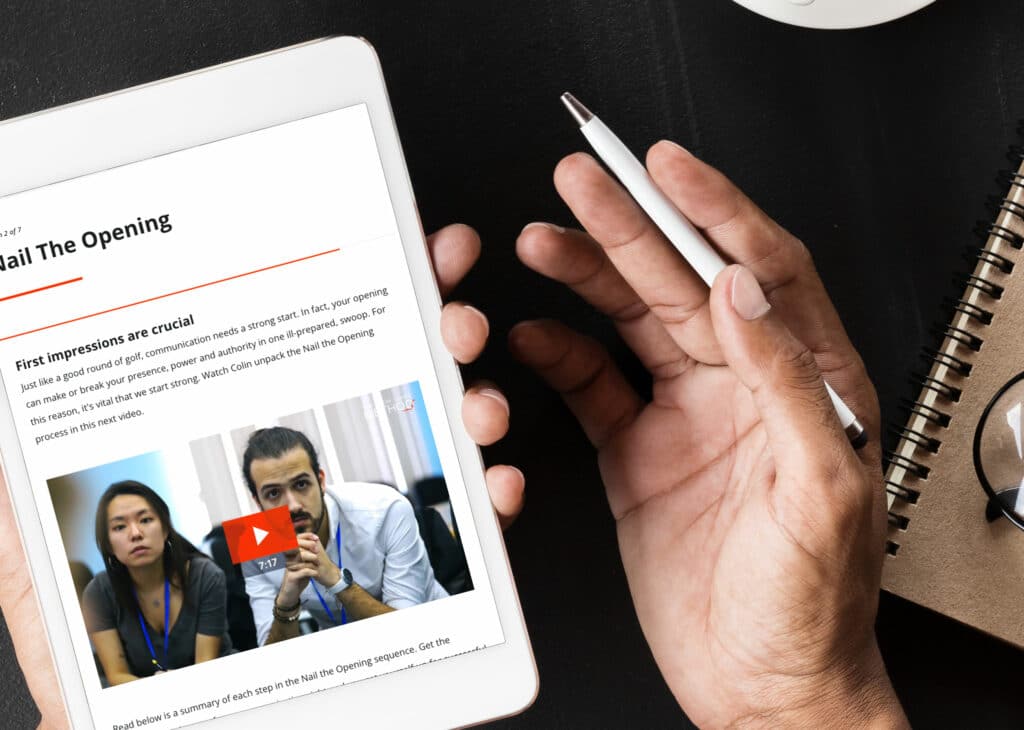“The big challenge for leaders is to teach the people around us how to accept discomfort as a part of growth.”
In the face of uncertainty, teams look to leaders to navigate the road towards a better tomorrow – for guidance on what to expect and how to act.
Admittedly, I’ve often asked senior executives what leadership qualities they value the most and vision always takes the lead, and for good reason. A vision motivates people and inspires them to strive for better. Whether it’s market domination, business expansion or personal growth, a leader’s vision gives teams the push they need to get the job done.
Wherever you go, they follow.
Even more so now, visionary leadership will play a greater role in crisis leadership as you empower your teams to take on more responsibility and manage their stress through this period of radical change.
Your teams can be motivated to achieve beyond the scope of their talents right now. But senior leaders fail to recognise the potential in helping organisational teams navigate stress purposefully.
Your organisation’s strengths and weaknesses during this crisis will have plenty to say for how leadership develops workforce talents in the middle of a crisis. You can drive these strengths using the Line of Tolerance framework to effectively manage your workforce during this time and get the best out of your teams.
The line of tolerance framework
In layman’s terms, the Line of Tolerance is a key leadership principle that enables executives to push their employees to manage more stress than they would under normal circumstances. Essentially, it advocates that leaders push their teams beyond their comfort zones by challenging them to extend their learning and capability.
For your teams, it means stepping out of their comfort zones and opening up to new experiences and greater expectations. As such, the Line of Tolerance might refer to significant organisational change.
“Conformity is the jailer of freedom and the enemy of growth.”
Here, you need to establish more open feedback loops and communication channels and giving them the push they need to adapt to new procedures and systems.
In 2007 I was working at Westpac and Gail Kelly had just taken over. Inside the bank, there was constant complaining about bureaucracy, how rules and process-driven our culture had become. Gail, who had an unstoppable desire to freshen up the culture, once stood in front of a room full of people and said something I’ll never forget.
She said, “Hands up who thinks they’re doing something, that takes up a lot of time, that doesn’t need to be done at all? Why are you doing it?”
The answer for many of us, of course, was that we were afraid of getting in trouble. Gail said, “I’m going to set you this challenge: stop doing it and see what happens.” Now, of course, this is simple, but when you’re armed with the words of the CEO to stop doing something that takes a lot of energy and achieves very little, without the fear of recrimination from your leaders, it is a big deal. That simple statement made a huge difference to help people move through the discomfort and stress of speaking out or challenging the norm. Sometimes something as simple as giving people permission can help them to lean into new places and establish a new culture.
It’s safe to say that across the board, senior leadership was caught unaware of the COVID-19 pandemic and its detrimental impact on both the workforce and the economy.
A Gartner study, for example, depicts senior leadership viewing employee resilience (40%) and mobility (32%) as their strengths – implying their teams are ready and willing to tackle the change. Simultaneously, however, the decision-making and creative thinking capabilities appear to be their greatest weaknesses.
Ultimately, we can conclude that executives aren’t equipping their teams with the tools and resources they need to make it out stronger. Leaders need to look beyond the horizon of short-term disruptions and nurture their teams to trust leadership to guide them through the unknown.
Consequently, regularly pushing your teams to evolve and grow their line of tolerance will permanently shift their tolerance to new heights – further developing their ability to take on and manage greater responsibility because they recognise the benefits that come with it.
That said, if they aren’t used to a sudden disruption, they will have no tolerance and can easily go into a state of distress – where the fear of what’s ahead eliminates the scope for learning or growth.
Here, leaders who create internal disruption and encourage their organisations to go beyond their current expectations will be the ones to increase their team’s line of tolerance and push them to learn and grow.
In the early 2000’s I worked as a corporate business banking leader. The bankers were operating in a very ‘administrative’ way and we were asking them to shift into a new paradigm. Where they were client-centric, rather than process-centric. It was a profound shift for many who had spent their life focussing on admin, to now get in front of customers more, sell more, and diagnose needs. A completely new skillset. People were resistant to this change. I recognised they were anxious because it was out of their comfort zone. They needed to be comfortable with the discomfort of getting out in front of clients. So we built in a framework that helped to explain the ‘why’ of this transition. We helped them understand that although they thought they were serving their customers well, the loss of market share was telling a different story.
Helping them connect to their customer’s needs was important. This helped them accept and trust the change. Once they leaned into the discomfort they realised they were serving their clients, not selling their product and were able to adapt and embrace this transition more easily. They pushed their boundaries of tolerance and evolved with our organisation as a result.
Challenging your employees to strive for more
“Keep your hand on the thermostat. If the heat’s too low, people won’t make difficult decisions. If it’s too high, they might panic.”
Motivating and challenging organisational teams to grow towards their potential will require executives to develop a keen eye for prospective growth. You want to push them to strive for more, rather than drain them of the energy to do the bare minimum.
Here are some of the main components of the crisis leadership using the line of tolerance framework that can help you helps employees advance their growth:
Keeping an eye for potential in others
Executives often underestimate the influence and authority that organisational leadership has within a company – and its ability to inspire change within the workforce.
Forbes notes that the Pygmalion theory is crucial to effective workforce management, given how employees perform based on management’s expectations of them. Expect too little from your employees, and watch them struggle to perform the bare minimum.
Challenge them to deliver more than that required of them, and you can give them the right nudge to excel in the workplace.
As leaders, you can shape the way employees think of themselves. Set high (still achievable) goals for your employees and watch them grow into their new expectations.
Soon enough, employees with the potential for growth will stand out. These employees have the potential it takes to be successful even in a crisis, because they have the tendency to grow into new expectations and forms of change.
Stepping out of complacency
In a crisis like the current pandemic, enabling your teams to develop the tolerance for ambiguity ahead of potential disasters can help you avoid panic and resistance to change in the long run.
Once recruits settle into your organisation, it isn’t long before they become comfortable with the environment and the work that they do. Admittedly, this is something you aim during the onboarding process. However, once they settle into their new roles, an immobility born out of comfort can be detrimental to the growth of your workforce.
Here, leadership training not only introduces ambiguity as a concept to prepare for but also incorporates resilience training to equip their employees with the knowledge and tools they need to fear complacency – above all else.
A learning process
Your teams are bound to fail along the way: they might fall behind on your expectations as well as their own career goals. As a leader, you need to frame your response to these circumstances to build hope and prosperity – rather than demoralise their spirits.
Openly discuss failure as a learning opportunity and as a necessary part of growth and communicate the potential you see for your teams to achieve beyond their current talents.
Five operating principles to help executives manage the unexpected across different types of crises
According to PWC research, over 50% of 2,084 senior executives said they experienced an average of five crises – one per year. For surveyors to capture the accurate results, they listed as many as 19 possible crisis triggers – and yet still, a pandemic wasn’t one of those mentioned.
Source: PWC Global Crisis Survey 2019
Consequently, 42% of those that had experienced a crisis, said they were in a better position to tackle future disasters – effectively emerging stronger and healthier.
Frame the crisis
A crisis is a continuously developing situation that will require you to prioritise innovation and creativity rather than comprehension of the situation.
As a leader, you need to be flexible and embrace new data as it comes along, and you will need to inspire your teams to do the same. If new information requires that you scrap out an entire plan, your teams need to be on the ready to adapt and improvise.
Crisis leadership mandates that you continuously frame the situation with the information you have and prepare your teams to adapt to an unknown tomorrow. Here, a tolerance for ambiguity will prove crucial to your success in managing any crisis.
Lead decisively
Involving your CEO to lead the day-to-day response to crisis isn’t necessarily a wise decision as it could distract them from executive-level business matters. Here, management will need to take the lead in driving innovation and resilience to change.
You need to lend support and take bold, decisive acts in guiding your teams forward.
Be flexible to change and willing to take a step back in the face of adversity. Adjust and take charge again – lead where you want your teams to follow.
Actively communicate
Communication of expectations and deliverables will be key to successfully managing your organisation in a crisis.
You need to control the message you deliver and be a source of truth for both the public and your teams. Understand that your teams will respond differently than during normal circumstances and that the typical organisational roles may not apply here – which will only further add to your team’s confusion and the situations unpredictability.
Consequently, you need to set expectations and communicate how your teams can deliver them. Plot out how external resources might be brought in to facilitate your team’s management of the situation.
Drive your teams towards actionable intelligence – you will need to support them as they navigate incoming intelligence. Simultaneously, trust your teams enough to branch out and come up with their own solutions.
Manage the crisis lifecycle, not just the event
According to the Ethisphere Crisis Management report, 64% of companies said they conduct drills on key risk areas annually, whereas 93% said they have a formal crisis management team on board for potential disasters. However, it is vital that you take on a proactive approach to preparing for potential disasters if you wish to have an effective response to a crisis event.
The effectiveness of an organisations response to workforce disruption depends on crisis leadership that prepares employees for the unexpected.
Build your crisis management approach with an emphasis on stress management, preparation, and resilience training to stay ahead of potential threats. The key operating principles here will be leadership training that incorporates response, recovery, and above all else, empathy for those affected and still struggling to cope with the situation.
Click here to find out more about our leadership training and how we can support you and your teams to strengthen these muscles and thrive in the future.
The Colin James Method® Facilitators train corporate executives to improve their professional communication skills with a proven methodology. Our highly trained Facilitators and Coaches are recognised for their experience in their fields and have worked with many individuals and organisations around the world to master the art of communication.















